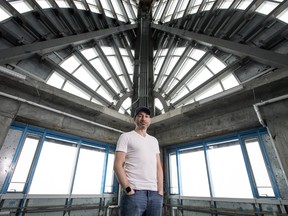Rockstars, Cabana parties and a DeLorean are par for the course as crypto elite gather amid downturn

Article content
Ethan Buchman wants crypto to get back to basics. You might not guess it from his nebular garb, replete with galactic icons and smoking unicorns, but the co-founder of the blockchain ecosystem Cosmos — who is moments away from delivering a Kendall Roy-esque rap about the virtues of crypto sovereignty (“Crypto please, you better bow down on both knees”) — thinks the sector’s excesses were due to for a shakeout.
Advertisement 2
Article content
“There’s a lot of over-exuberance and optimism and hyper-financialization — and it’s nice to kind of clear a lot of that out and be able to focus again on, really, what we’re here to build and we’re trying to address: fundamental issues in the monetary and financial system,” Buchman said in an interview, before taking the stage at the Blockchain Futurist Conference in Toronto this week.
The notion of a reset was a common refrain at this year’s edition of the conference, which took over the Rebel nightclub in the city’s Port Lands district, the first time it has been held in person since 2019. The event brought together a who’s who of the Canadian industry, from crypto rock stars such as Vitalik Buterin, founder of Ethererum, to real ones, such as Raine Maida, front man of the band Our Lady Peace. It came with a carnival atmosphere, with attendees lining up outdoors for temporary airbrush tattoos, cotton candy and popcorn and, in keeping with crypto’s spirit, there were pool tables, foosball tables, helicopter rides and even a DeLorean parked out front.
Advertisement 3
Article content
There were also big questions hanging over the event. After a soaring run propelled by the pandemic, the crypto sector has been in retreat. Bitcoin remains down more than 60 per cent from its all-time high peak of over US$65,000 in 2021, a decline that has sparked fears of a new “crypto winter” — the preferred term for a sustained downturn in the space. Hundreds of billions of dollars have been wiped from the market capitalizations of various coins, losses that brought with them more trouble, including the collapse of the TerraUSD stablecoin and its Luna token as well as the bankruptcy of Celsius, a crypto lender that owes clients more than US$4 billion. With many investors feeling burned and crypto increasingly in the crosshairs of regulators, the sector is facing a credibility challenge.
Advertisement 4
Article content
But while there were some signs of soul searching at the conference, there was no sense among the faithful that the crypto party is over.

“There’s still a huge amount of potential in this industry, I think these corrections are generally healthy,” Buchman said.
Tanim Rasul, chief operating officer at Canadian crypto exchange NDAX, also saw the downturn as an opportunity.
“Bear markets are the best time for you to put your head down and get to work,” Rasul said, during an appearance on the main stage. “Because I promise you, when that bull run happens, you don’t have time. You’ve got to be firing on all cylinders during the bull market.”
Anthony Di Iorio, the co-founder of Ethereum and more recently the founder and chief executive of Toronto-based crypto software company Decentral, took to the stage to share his own experiences in previous cycles when cryptocurrencies went bust.
Advertisement 5
Article content
“2018 was probably the toughest year that I went through,” Di Iorio said, referring to the crypto crash that sent the price of bitcoin down over 60 per cent to just under US$7,000. “Hopefully not as similar as what we’re going through right now and what we’re going to go through, but 2018 was when all of the hype and the noise and the (initial coin offering) craze disintegrated.… It was really one of those crashes that for me, personally, was a major reset.”

This time around, Di Iorio is teeing up a new project called Andiami, set to go public in November that he hopes will serve as a foundation for blockchain problem solvers. The project has already launched a white list that enthusiasts can join.
Ethereum founder Vitalik Buterin, whose rock-star-like presence drew a crowd that packed the main hall wall-to-wall, also focused on the potential for further innovation.
Advertisement 6
Article content
Buterin pointed to this year’s developments such as “The Merge” — Ethereum pending switch from proof of work to proof of stake — which will make the network cheaper, more secure, and open it up to more upgrades in the future, drawing some cheers from the crowd.

“This is what I hope we can start thinking about more,” Buterin said, opting to leave the details of how the technology will be used up for audience interpretation. “The technical improvements are happening and they’re going to happen — but what kinds of improvements, in terms of what we use Ethereum for, are these things going to make possible?”
Budd White, co-founder of from U.S.-based crypto compliance software company Tacen, pointed to the failed fluff projects and ponzi-styled scams that proliferated the space over the years for this year’s collapse, and echoed Buchman’s reality check.
Advertisement 7
Article content
“People forgot why we do this,” White said. “They jumped on the hype train (and) Wall Street got involved… We have to go back to basics.”
Still, the conference was also home to many of the questionable practices that traditionalists in the crypto space warned about, with attendees promoting new altcoins with promises that investors getting in on the ground floor will see their investments grow astronomically.
“That’s what we’re trying to get away from,” said Raine Maida, front man of Canadian rock band Our Lady Peace and founder of digital collectibles company Drrops Inc.

Maida, who has been an advocate for the underlying technology with NFTs in the music industry, said he was drawn to the space when it was pitched to him as a way to track royalties in music and ensure artists are paid directly. Engaging with fans without the middleman by using NFT drops and possibly addressing the bot and scalping issue in concert ticket sales are also crucial to the musician.
Advertisement 8
Article content
However, he acknowledged that the fraudulent and speculative side of the space has not done the ecosystem any favours.
“Just the word ‘NFT’ to me, it might be tarnished for good,” Maida said, emphasizing the need to step away from the fear-of-missing-out mindset. “There’s so much more value in Web3 in terms of how it can really cause this paradigm shift. We will look back on this (winter of 2021)… It was like Woodstock… It was crazy, but it’ll be a blip.”
Of course, it wouldn’t be a crypto conference without a few bells and whistles. On top of the helicopter rides ($169, payable in crypto, of course), partygoers who were missing the Floridian vibe of the Miami Bitcoin Conference could lounge on the umbrella-dotted patios overlooking the harbour, with the city skyline as picturesque backdrop amid thumping club music and passing party boats.
Advertisement 9
Article content
-

Ethereum is at a crossroads and needs to start delivering on its revolutionary potential
-

U.S. imposes sanctions on ‘crypto mixer’ Tornado Cash over alleged laundering
-

Coinbase racks up $1.1 billion loss as crypto trading volumes slump
As the summer evening sky over the Cabana party changed to a pale purple, the air was thick with talk of when the next bull market might arrive.
Whether it was a community in denial of the financial damage of the past year, or a gathering of true believers, the mood was overwhelmingly positive.
“It was three years in the making, the community really came up bigger than ever — it’s actually the largest crypto event in the history of Canada,” said MC Mahyar Akhbari as he took the stage for closing remarks. “We’ll be back later again next year, bigger and better than ever.”
• Email: shughes@postmedia.com | Twitter: StephHughes95





